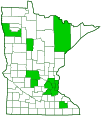broad-handed leafcutting bee
(Megachile latimanus)
Conservation • Description • Habitat • Ecology • Distribution • Taxonomy
|
|
||||||||||||||
Description |
Broad-handed leafcutting bee is a stout, moderately-sized, dark-colored, solitary, ground-nesting bee. The female is ½″ to 9 ⁄16″ long. The head is black and is densely covered around and below with short, pale yellowish hairs. The mandibles are enlarged and scissor-like with beveled edges and 5 teeth. The antennae are black and have 12 segments. The tongue is elongated. The body is entirely black. The thorax is densely covered with long yellowish hairs and copious shorter black hairs. There are six hardened plates (tergites) on the upper (dorsal) portion of the abdomen (metasoma). The first and second tergites (T1 and T2) are densely covered with long, erect, pale yellowish hairs. The hairs near the front (apex) of T3 and T4 are black. Most of the hairs on T5 are black. The hairs on T6 are mostly pale yellowish. The branched, pollen-carrying hairs (scopae) on the under (ventral) side of the abdomen are yellowish-orange. The wings are semitransparent with brownish-black veins. The broad lobe at the base of the hindwing (jugal lobe) is shorter than the narrow lobe adjacent to it (submedian lobe). The male is slightly smaller. It has seven tergites and 13 antenna segments. |
Size |
Female: ½″ to 9 ⁄16″ Male: ½″ |
Similar Species |
Habitat |
Dry; savannas, grasslands, and agricultural fields. |
Ecology |
Season |
May to October |
Behavior |
|
Life Cycle |
After mating, the female locates a nest site usually in a hole bored in wood or a rock crevice. She then cuts small circular discs of leaves, rolls them between her legs, and transports them to the nest one at a time. The discs are glued together to form a cylinder. The cylinder is then filled with all the nectar and pollen the larva will need throughout its development. She then lays a single egg on top of the food and seals the cylinder with another leaf cutting. She continues the process, laying one egg per day for usually about 28 days. Fertilized eggs produce female bees, unfertilized eggs produce male bees. After hatching the larva will molt several times before pupating and finally metamorphosing into an adult. The adult overwinters in the nest, emerging in the spring. |
Larva Food |
Regurgitated nectar and shed pollen of legume flowers |
Adult Food |
Nectar and pollen of legume flowers |
Distribution |
||
|
Sources Biodiversity occurrence data published by: Minnesota Biodiversity Atlas (accessed through the Minnesota Biodiversity Atlas Portal, bellatlas.umn.edu, 8/12/2025). |
|
| 8/12/2025 | ||
Occurrence |
||
Common and widespread |
||
Taxonomy |
|
Order |
Hymenoptera (Ants, Bees, Wasps, and Sawflies) |
Suborder |
Apocrita (Narrow-waisted Wasps, Ants, and Bees) |
Infraorder |
Aculeata (Ants, Bees, and Stinging Wasps) |
Superfamily |
Apoidea (Bees and Apoid Wasps) |
Epifamily |
|
Family |
Megachilidae (mason, leafcutter, carder, and resin bees) |
Subfamily |
Megachilinae |
Tribe |
Megachilini |
Genus |
|
Subgenus |
Xanthosarus |
Subordinate Taxa |
|
|
|
Synonyms |
|
Megachile acuta Megachile vidua Xanthosarus latimanus |
|
Common Names |
|
broad-handed leafcutting bee broad-handed leaf-cutter bee leafcutting bee |
|
Glossary
Tergite
The upper (dorsal), hardened plate on a segment of the thorax or abdomen of an arthropod. Plural: terga.
Visitor Photos |
||
Share your photo of this insect. |
||
This button not working for you? |
||
Cynthia Thomas |
||
I found this bee on a plantain seed stalk. After watching it a bit, I was curious about it and let it crawl onto my finger. It seemed like it might not be able to fly yet, so I placed it onto the Joe Pye that was next to me (it didn't fly there). It seemed to get busy, but sounds like they need or prefer legumes. |
||
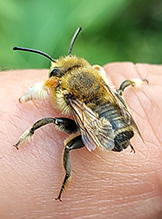 |
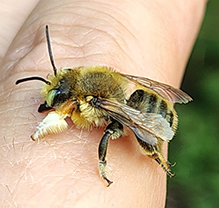 |
|
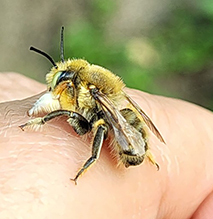 |
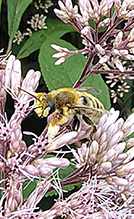 |
|
 |
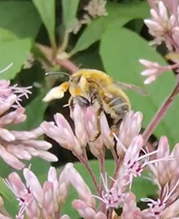 |
|
Bill Reynolds |
||
The Milkweed was a buzz this day with many different types of bees and butterflies. |
||
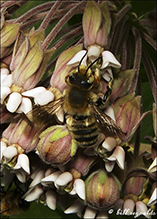 |
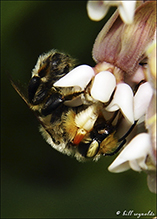 |
|
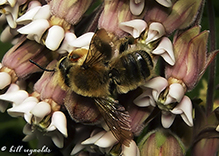 |
||
MinnesotaSeasons.com Photos |
||
|
||
|
||

Slideshows |
|

Visitor Videos |
||
Share your video of this insect. |
||
This button not working for you? |
||
|
Other Videos |
||
|

Visitor Sightings |
||
Report a sighting of this insect. |
||
This button not working for you? |
||
| Tammi Jul-Aug 2014 |
Location: New Brighton Leaf cutting bees have been busy on my wisteria vine! |
|
| Bill Reynolds 8/5/2003 |
Location: St. Louis Co. The Milkweed was a buzz this day with many different types of bees and butterflies. |
 |
| Bill Reynolds 7/31/2003 |
Location: St. Louis Co. |
 |
MinnesotaSeasons.com Sightings |
||
|

Created: 2/2/2014 Last Updated: © MinnesotaSeasons.com. All rights reserved. |
